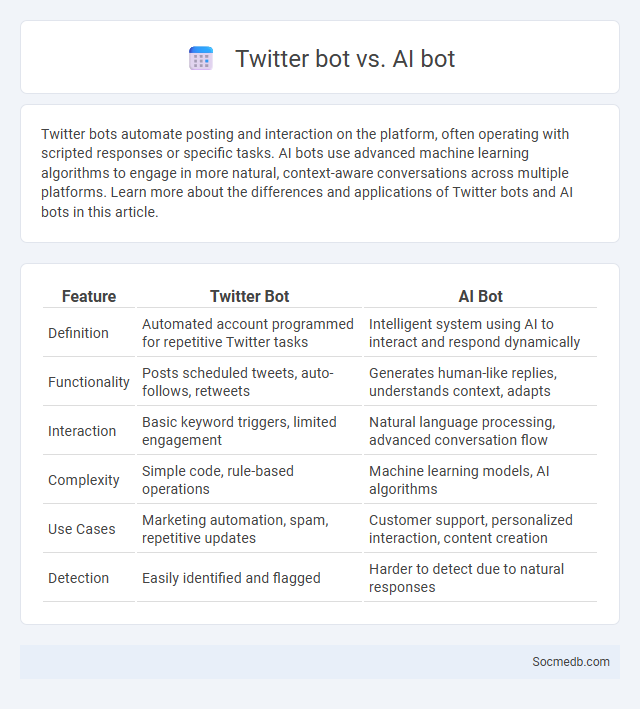
Photo illustration: Twitter Bot vs AI Bot
Twitter bots automate posting and interaction on the platform, often operating with scripted responses or specific tasks. AI bots use advanced machine learning algorithms to engage in more natural, context-aware conversations across multiple platforms. Learn more about the differences and applications of Twitter bots and AI bots in this article.
Table of Comparison
| Feature | Twitter Bot | AI Bot |
|---|---|---|
| Definition | Automated account programmed for repetitive Twitter tasks | Intelligent system using AI to interact and respond dynamically |
| Functionality | Posts scheduled tweets, auto-follows, retweets | Generates human-like replies, understands context, adapts |
| Interaction | Basic keyword triggers, limited engagement | Natural language processing, advanced conversation flow |
| Complexity | Simple code, rule-based operations | Machine learning models, AI algorithms |
| Use Cases | Marketing automation, spam, repetitive updates | Customer support, personalized interaction, content creation |
| Detection | Easily identified and flagged | Harder to detect due to natural responses |
Understanding Bots: Definitions and Types
Social media bots are automated programs designed to perform specific tasks such as liking, sharing, or commenting on posts to simulate human activity. These bots vary in complexity, ranging from simple scripts that spread spam to advanced AI-driven agents capable of engaging in conversations or influencing public opinion. Understanding the different types of social media bots helps you identify their impact on engagement metrics and recognize potential threats to authentic interactions on your platforms.
What is a Twitter Bot?
A Twitter bot is an automated software application designed to perform tasks such as posting tweets, retweeting, liking, and following accounts based on programmed instructions or algorithms. These bots can disseminate information rapidly, engage with users, or manipulate trends by amplifying specific content on the platform. Understanding Twitter bots is crucial for identifying authentic user interactions and combating misinformation within social media ecosystems.
Exploring AI Bots: Capabilities and Uses
AI bots on social media platforms enhance user experiences by automating interactions, curating personalized content, and providing real-time customer support. These intelligent agents analyze vast amounts of data to identify trends, enabling targeted marketing and efficient communication. You can leverage AI bots to optimize engagement, streamline workflows, and gain valuable insights into audience behavior.
The Basics: General Bots Explained
Social media bots are automated software programs designed to perform repetitive tasks such as posting content, liking posts, and following accounts on platforms like Twitter, Facebook, and Instagram. These bots vary in complexity, ranging from simple scripts that amplify content to advanced AI-driven entities capable of mimicking human behavior and engaging in conversations. Understanding the general functions and motivations behind social media bots is crucial for recognizing their impact on online engagement, marketing strategies, and misinformation spread.
Key Differences: Twitter Bot vs AI Bot vs General Bot
Twitter bots are specifically designed to automate interactions on the Twitter platform, such as posting tweets, retweeting, and following users, optimizing social engagement solely within that ecosystem. AI bots utilize advanced machine learning algorithms to simulate human conversation and decision-making across various platforms, enhancing personalization and contextual understanding in your interactions. General bots function based on predefined scripts or rules without learning capabilities, performing repetitive tasks across diverse systems but lacking the adaptability and intelligence of AI-driven bots.
Use Cases: Where Each Bot Excels
Customer service bots on social media excel in handling inquiries and resolving issues quickly, reducing response times and increasing user satisfaction. Marketing automation bots are highly effective in delivering personalized content and promotions, boosting engagement and conversion rates. Social listening bots gather real-time insights from conversations, enabling brands to monitor sentiment and adapt strategies promptly.
Strengths and Weaknesses of Each Bot Type
Social media bots vary in strengths and weaknesses, with chatbots excelling at real-time customer interaction but sometimes struggling with complex queries, while content bots efficiently generate and share posts but may lack personalization and context. Influencer bots amplify brand presence quickly but risk authenticity and audience trust issues. Understanding these nuances helps you strategically deploy bots that maximize engagement while minimizing potential backlash.
Ethical Considerations in Bot Deployment
Ethical considerations in social media bot deployment require ensuring transparency and preventing manipulation or misinformation. Bots should be designed to respect user privacy and avoid deceptive interactions that can harm social trust. You must prioritize responsible use to maintain the integrity and authenticity of online communities.
Security Risks and Prevention Strategies
Social media platforms expose Your personal data to security risks such as phishing attacks, identity theft, and unauthorized access. Strong prevention strategies include using two-factor authentication, regularly updating passwords, and being cautious about sharing sensitive information. Employing privacy settings to control who can view Your content significantly reduces vulnerability to cyber threats.
Future Trends in Bot Development and Usage
Future trends in social media bot development emphasize enhanced AI-driven personalization and real-time interaction capabilities, enabling more engaging and context-aware responses. Bot usage will increasingly integrate advanced natural language processing and machine learning algorithms to deliver tailored content and support, improving user experience significantly. Your social media strategy should leverage these intelligent bots to automate customer service, boost engagement, and analyze user behavior effectively.
 socmedb.com
socmedb.com